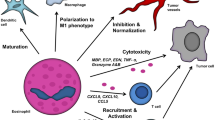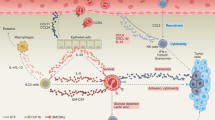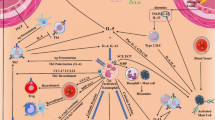Summary
On the basis of our clinical findings that the ability of cancer patients to generate lymphokine-activated killer cells became markedly augmented after mitomycin C administration, we designed a treatment regimen comprising mitomycin C 12 mg/m2, i.v. on day 1 and recombinant interleukin-2 700 U/m2 (8000 IU/kg), i.v. every 12 h from day 4 through day 8. The treatment course was repeated at almost 7-day intervals. Altogether 33 patients with advanced carcinoma, including mainly gastrointestinal carcinoma, were treated with this regimen. Of these, 10 had a partial response (PR) and 4 had a minor response (MR). Since eosinophil counts peaked 1 day after either the first or second course of the therapy, the posttreatment values were compared to each pretreatment level, with regard to the clinical antitumor response to this treatment. When patients who showed PR were defined as responders, absolute eosinophil counts and the percentages of eosinophils in responders after both the first and second courses of the therapy were significantly greater than each pretreatment value or the posttreatment level in nonresponders. Further, these findings were almost identical, when both PR and MR were considered to be a true remission and therefore patients who exhibited PR or MR were defined as responders, although the difference between posttreatment levels of eosinophils in responders and nonresponders was not significant at the second course. These results indicate that eosinophilia induced by this treatment correlates with the clinical response to this therapy.
Similar content being viewed by others
References
Akiyoshi T, Arinaga S, Karimine N, Inoue H, Abe R, Takamuku K, Watanabe D, Nagamatsu M, Matsuoka H, Ueo H (1990) Effect of recombinant interleukin 2 in combination with mitomycin C or Adriamycin on advanced cancer. Proc Am Assoc Cancer Res 31: 273
Akiyoshi T, Arinaga S, Nanbara S, Karimine N, Inoue H, Takamuku K, Abe R, Watanabe D, Nagamatsu M, Matsuoka H, Ueo H (1990) The effect of interleukin 2 in combination with mitomycin C on advanced cancer. Jpn J Surg 20: 365
Blay J-Y, Favrot MC, Negrier S, Cambaret V, Chouaib S, Mercatellow A, Kaemmerlen P, Franks CR, Philip T (1990) Correlation between clinical response to interleukin 2 therapy and sustained production of tumor necrosis factor. Cancer Res 50: 2371
Bukowski RM, Goodman P, Crawford ED, Sergi JS, Redman BG, Whitehead RP (1990) Phase II trial of high-dose intermittent interleukin-2 in metastatic renal cell carcinoma: a Southwest Oncology Group study. J Natl Cancer Inst 82: 43
Clutterbuck EJ, Hirst EMA, Sanderson CJ (1989) Human interleukin-5 (IL-5) regulates the production of eosinophils in human bone marrow cultures: comparison and interaction with IL-1, IL-3, IL-6, and GMCSF. Blood 73: 504
Eberlein TJ, Rodrick ML, Massaro AF, Jung S-E, Mannick JA, Schoof DD (1989) Immunomodulatory effects of systemic low-dose recombinant interleukin-2 and lymphokine-activated killer cells in humans. Cancer Immunol Immunother 30: 145
Ettinghausen SE, Moore JG, White DE, Platani L, Young NS, Rosenberg SA (1987) Hematologic effects of immunotherapy with lymphokine-activated killer cells and recombinant interleukin-2 in cancer patients. Blood 59: 1654
Forni G, Giovarelli M, Santoni A, Modesti A, Forni M (1986) Tumor inhibition by interleukin-2 at tumour host interface. Biochim Biophys Acta 865: 307
Gemlo BT, Palladino MA, Jaffe HS, Espevik TP, Rayner AA (1988) Circulating cytokines in patients with metastatic cancer treated with recombinant interleukin 2 and lymphokine-activated killer cells. Cancer Res 48: 5864
Hinuma S, Onda H, Naruo K, Ichimori Y, Koyama M, Tsukamoto K (1982) Translation of interleukin 2 mRNA from human peripheral blood leukocytes in Xenopus oocytes. Biochem Biophys Res Commun 109: 363
Kasid A, Director EP, Rosenberg SA (1989) Induction of endogenous cytokine-mRNA in circulating peripheral blood mononuclear cells by IL-2 administration to cancer patients. J Immunol 143: 736
Kolb E, Muller E (1979) Local response in primary and secondary human lung cancers: II. Clinical correlations. Br J Cancer 40: 410
Kovach JS, Gleich GJ (1986) Eosinophilia and fluid retention in systemic administration of interleukin 2. J Clin Oncol 4: 815
Kovacs EJ, Becker SK, Longo DL, Varesio L, Young HA (1989) Cytokine gene expression during the generation of human lymphokine-activated killer cells: early induction of interleukin 1 by interleukin 2. Cancer Res 49: 940
Lopez AF, Williamson J, Gamble JR, Begley CG, Harlan JM, Klebanoff SJ, Waltersdorph A, Wong G, Clark SC, Vadas MA (1986) Recombinant human granulocyte-macrophage colony-stimulating factor stimulates in vitro mature human neutrophil and eosinophil function, surface receptor expression, and survival. J Clin Invest 78: 1220
Lopez AF, Sanderson CJ, Gamble JR, Campbell HD, Young IG, Vadas MA (1988) Recombinant human interleukin 5 is a selective activator of human eosinophil function. J Exp Med 167: 219
Lowe D, Lorizzo J, Hutt M (1981) Tumour-associated eosinophilia: a review. J Clin Pathol 34: 1343
Mier JE, Vacino G, Van Der Meer JW, Numerof RP, Adams S, Cannon JG, Berheim HA, Atkins MB, Parkinson DR, Danarello CA (1988) Induction of circulating tumor necrosis factor (TNF-α) as the mechanisms for febrile response to interleukin-2 (IL-2) in cancer patients. J Clin Immunol 8: 426
Mitchell MS, Kempf RA, Harel W, Shau H, Boswell WD, Lind S, Bradley EC (1988) Effectiveness and tolerability of low-dose cyclophosphamide and low-dose intravenous interleukin-2 disseminated melanoma. J Clin Oncol 6: 409
Nanbara S, Arinaga S, Akiyoshi T (1989) Augmentation of the generation of lymphokine-activated killer cells after a single dose of mitomycin C in cancer patients. Cancer Immunol Immunother 29: 237
Pretlow TP, Keith EF, Cryar AK, Bartolucci AA, Pitts AM, Pretlow TG, Kimball PM, Boohaker EA (1983) Eosinophil infiltration of human colonic carcinomas as a prognostic indicator. Cancer Res 43: 2997
Rosenberg SA, Lotze MT, Muul JM, Chang AE, Avis EP, Leitman S, Linehan WM, Robertson CN, Lee RE, Rubin JT, Seipp CA, Simpson CG, White MS (1987) A progress report on the treatment of 157 patients with advanced cancer using lymphokine-activated killer cells and interleukin-2 or high dose IL 2 alone. N Engl J Med 316: 889
Rothenberg ME, Owen WF Jr, Silverstein DS, Woods J, Soberman RJ, Austin KF, Stevens RL (1988) Human eosinophils have prolonged survival, enhanced functional properties, and become hyperdense when exposed to human interleukin 3. J Clin Invest 81: 1986
Silverstein DS, Schoof DD, Rodrick ML, Tai P-O, Spry CJF, David JR, Eberlein TJ (1989) Activation of eosinophils in cancer patients treated with IL-2 and IL-2-generated lymphokine-activated killer cells. J Immunol 142: 2162
Taguchi T, Kimoto Y (1987) Clinical application of biological response modifiers: interleukin 2. Saishin-Igaku (in Japanese) 42: 325
Thompson JA, Lee DJ, Lindgren CG, Benz LA, Collins C, Levitt D, Fefer A (1988) Influence of dose and duration of infusion of interleukin-2 on toxicity and immunomodulation. J Clin Oncol 6: 669
Urba WJ, Steis RG, Longo DL, Kopp WC, Maluish AE, Marson L, Nelson DL, Stevenson HC, Clark JW (1990) Immunomodulatory properties and toxicity of interleukin 2 in patients with cancer. Cancer Res 50: 185
Wang J, Walle A, Gordon B, Nobogrodsky A, Suthanthiran M, Rubin AL, Morrison H, Silver RT, Stenzel KH (1987) Adoptive immunotherapy for stage IV renal cell carcinoma: a novel protocol utilizing periodate and interleukin-2-activated autologous leukocytes and continuous infusions of low-dose interleukin-2. Am J Med 83: 1016
West WH, Tanner KW, Yanelli JR, Marshall GD, Orr DW, Thurmann GB, Oldham RT (1987) Constant infusion recombinant interleukin-2 in adoptive immunotherapy of advanced cancer. N Engl J Med 316: 398
Yamaguchi Y, Suda T, Shiozaki H, Miura Y, Hitoshi Y, Tominaga A, Takatsu K, Kasahara T (1990) Role of IL-5 in IL-2-induced eosinophilia: in vivo and in vitro expression of IL-5 mRNA by IL-2. J Immunol 145: 873
Author information
Authors and Affiliations
Rights and permissions
About this article
Cite this article
Arinaga, S., Karimine, N., Takamuku, K. et al. Correlation of eosinophilia with clinical response in patients with advanced carcinoma treated with low-dose recombinant interleukin-2 and mitomycin C. Cancer Immunol Immunother 35, 246–250 (1992). https://doi.org/10.1007/BF01789330
Received:
Accepted:
Issue Date:
DOI: https://doi.org/10.1007/BF01789330




